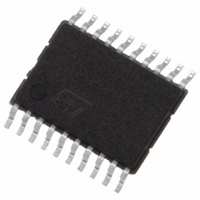STPM11ATR STMicroelectronics, STPM11ATR Datasheet - Page 12

STPM11ATR
Manufacturer Part Number
STPM11ATR
Description
IC ENERGY METER 1 PHASE 20TSSOP
Manufacturer
STMicroelectronics
Datasheet
1.STPM13ATR.pdf
(46 pages)
Specifications of STPM11ATR
Input Impedance
100 KOhm
Measurement Error
0.1%
Voltage - I/o High
1.5V
Voltage - I/o Low
0.8V
Current - Supply
4.7mA
Voltage - Supply
3 V ~ 5.5 V
Operating Temperature
-40°C ~ 85°C
Mounting Type
Surface Mount
Package / Case
20-TSSOP
Meter Type
Single Phase
Output Voltage
+/- 0.4 V
Output Current
150 mA
Input Voltage
3 V to 5.5 V
Operating Temperature Range
- 40 C to + 85 C
Mounting Style
SMD/SMT
Lead Free Status / RoHS Status
Lead free / RoHS Compliant
Other names
497-5984-2
Terminology
5
5.1
5.2
5.3
5.4
5.5
12/46
Terminology
Measurement error
The error associated with the energy measured by STPM1X is defined as:
Percentage Error = [STPM1X (reading) - True Energy] / True Energy
ADC offset error
This is the error due to the DC component associated with the analog inputs of the A/D
converters. Due to the internal automatic DC offset cancellation, the STPM1X measurement
is not affected by DC components in voltage and current channel. The DC offset
cancellation is implemented in the DSP.
Gain error
The gain error is gain due to the signal channel gain amplifiers. This is the difference
between the measured ADC code and the ideal output code. The difference is expressed as
a percentage of the ideal code.
Power supply DC and AC rejection
This parameter quantifies the STPM1X measurement error as a percentage of the reading
when the power supplies are varied. For the PSRR
nominal supply voltages (3.3 and 5 V) is taken. A second reading is obtained with the same
input signal levels when an ac (200 mV
voltages. Any error introduced by this ac signal is expressed as a percentage of reading.
For the PSRR
taken. A second reading is obtained with the same input signal levels when the supplies are
varied ±10%. Any error introduced is again expressed as a percentage of the reading.
Conventions
The lowest analog and digital power supply voltage is named V
system Ground (GND). All voltage specifications for digital input/output pins are referred to
GND.
Positive currents flow into a pin. Sinking current means that the current is flowing into the pin
and is positive. Sourcing current means that the current is flowing out of the pin and is
negative.
The timing specifications of the signal treated by digital control are relative to CLKOUT. This
signal is provided by from the crystal oscillator of 4.194 MHz nominal frequency or by the
internal RC oscillator. An external source of 4.194 MHz or 8.192 MHz can be used.
The timing specifications of signals of the CFGI interface are relative to the SCL-NLC, there
is no direct relationship between the clock (SCL-NLC) of the CFGI interface and the clock of
the DSP block.
A positive logic convention is used in all equations.
DC
measurement, a reading at two nominal supply voltages (3.3 and 5 V) is
Doc ID 13167 Rev 7
RMS
/100 Hz) signal is introduced onto the supply
AC
STPM11, STPM12, STPM13, STPM14
measurement, a reading at two
SS
which represents the












